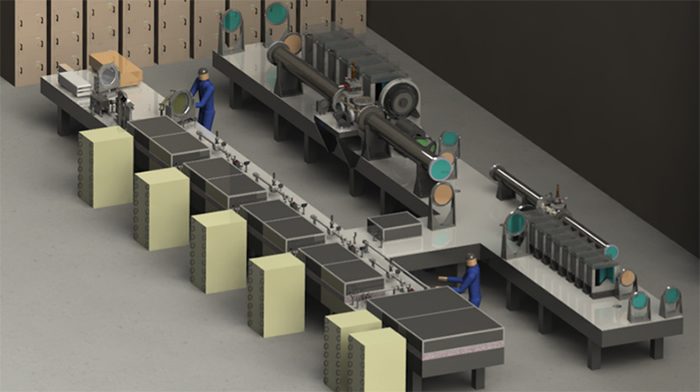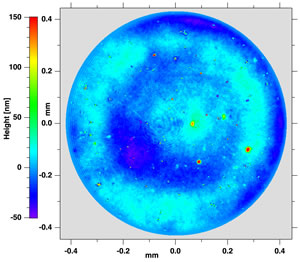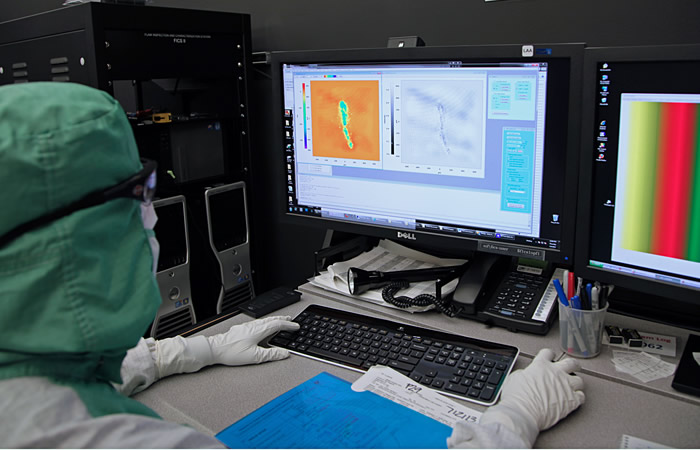Science & Technology - 2014
October
LLNL to Play Key Role in 10-Petawatt Laser Project
LLNL has again been selected to support the development and construction of an ultra-intense laser system for the European Union’s Extreme Light Infrastructure Beamlines facility (ELI-Beamlines) in the Czech Republic.
A consortium led by National Energetics, Inc., in partnership with Ekspla UAB, was awarded the contract to construct the system, which will be the most powerful laser of its class in the world, capable of producing peak power in excess of 10 petawatts (PW), or 10 quadrillion watts. Due to LLNL’s long-standing expertise in laser research and development, the consortium selected the Laboratory for a $3.5 million subcontract to support development of the new system.
“The award of this project is another clear statement of the internationally leading nature of LLNL’s laser design capability,” said Mike Dunne, LLNL’s director of laser fusion energy. “It is also another great example of where LLNL is helping move forward the global state-of-the-art of high-power lasers, working collaboratively with U.S. and European industry and academia. We are very excited to work with the National Energetics consortium, who have a very compelling approach to reaching the 10 petawatt goal.”
 3D CAD rendering of the ELI-Beamlines 10-petawatt laser system. (Credit: National Energetics, Inc.)
3D CAD rendering of the ELI-Beamlines 10-petawatt laser system. (Credit: National Energetics, Inc.) Under the subcontract, LLNL will be responsible for contributing to the physics design of the liquid-cooled laser amplifier, allowing it to get to the high energies required for accessing 10 PW power; contributing to the physics and engineering design of the short-pulse compressor, which takes the high-energy beam and compresses it to the required pulse length; and producing the large aperture diffraction gratings for the compressor.
The system will be one of the four major beamlines at the new ELI-Beamlines facility. In addition to work on this beamline, LLNL is also responsible for the design, development and installation of a second beamline at the facility, through a more than $45 million contract awarded in 2013. When commissioned to its full design performance, the laser system, called the “High Repetition-rate Advanced Petawatt Laser System” (HAPLS), will be the world’s highest average-power petawatt laser system. The two systems will thus offer a highly attractive capability for the new ELI-Beamlines facility, which will appeal to academic and industrial researchers from across the world.
LLNL’s Phase-Shifting Diffraction Interferometer Has Many Uses
 The PSDI mapping of the surface height measurements of the outside surface of part of a NIF target capsule; the three-nanometer precision of the shell inspector in measuring occasional 300-nanometer bumps on capsules is comparable to seeing a 60-foot hill on the surface of the Earth from about 140,000 miles out in space (about halfway to the moon).
The PSDI mapping of the surface height measurements of the outside surface of part of a NIF target capsule; the three-nanometer precision of the shell inspector in measuring occasional 300-nanometer bumps on capsules is comparable to seeing a 60-foot hill on the surface of the Earth from about 140,000 miles out in space (about halfway to the moon). Phase-shifting diffraction interferometer (PSDI) technology developed at LLNL during the 1990s is now being put to a number of uses in support of NIF target development and optics inspection. PSDI’s ability to make digital 3-D holographic images allows it to be adapted to a wide variety of applications.
One example is a PSDI “shell inspector” developed by NIF&PS researcher Mike Johnson and LLNL and General Atomics (GA) colleagues that has the capability of mapping the exterior surface features of NIF target capsules with nanometer (billionths of a meter)-scale precision. It is one of the current family of PSDI-based instruments that maps the outer surfaces of all NIF target capsules at the GA target production site in San Diego.
Another PSDI variation has been used to examine the frozen deuterium-tritium fuel layers in NIF targets, and a third variation characterizes optical flaws found in the bulk or on the surfaces of any of the large optics, such as grating debris shields, in the NIF Final Optics Assembly.
PSDI measurements also serve as feedback to achieve nanometer-scale precision of laser-based chemical vapor deposition (LCVD), which is being explored as a method for mitigating laser-induced damage to fused silica optics; a paper describing this process was highlighted in the July “Spotlight on Optics” feature on the Optics Infobase Website.
Finally, a new system is coming on line to measure the extremely thin (10-nanometer) plastic tent material used to support the target capsule inside NIF target assemblies.
The PSDI technology was invented by the late Gary Sommargren for the lab’s Extreme Ultraviolet Lithography (EUVL) program in the 1990s.
 (Above) Mike Johnson sets up a target capsule hemisphere in a phase-shifting diffraction interferometer as part of a campaign to determine the homogeneity of a NIF target capsule’s plastic material. Johnson has been at LLNL since 1976 and has had roles in the AVLIS isotope separation program and the current NIF and Diode-Pumped Alkali Laser programs, where he continues to work on interferometry, spectroscopy, physical optics, and large-scale integrated experiments. (Below) Optics technician Paul Cattolica takes a PSDI measurement from a flaw identification and characterization station image of a grating debris shield defect in the NIF optics processing facility.
(Above) Mike Johnson sets up a target capsule hemisphere in a phase-shifting diffraction interferometer as part of a campaign to determine the homogeneity of a NIF target capsule’s plastic material. Johnson has been at LLNL since 1976 and has had roles in the AVLIS isotope separation program and the current NIF and Diode-Pumped Alkali Laser programs, where he continues to work on interferometry, spectroscopy, physical optics, and large-scale integrated experiments. (Below) Optics technician Paul Cattolica takes a PSDI measurement from a flaw identification and characterization station image of a grating debris shield defect in the NIF optics processing facility.



